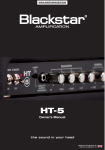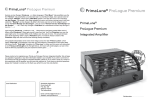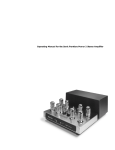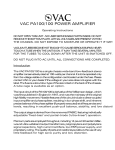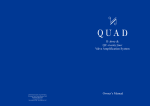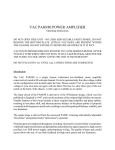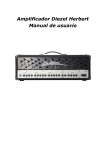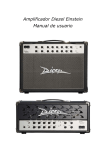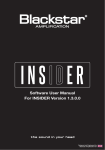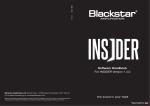Download Blackstar S1-45 Owner`s manual
Transcript
Owner’s Manual Designed and Engineered by Blackstar Amplification UK IMPORTANT SAFETY INSTRUCTIONS 1. Read these instructions. USA / Canada 2. Keep these instructions 3. Heed all warnings. 4. Follow all instructions. 5. Do not use this apparatus near water. 6. Clean only with dry cloth. 7. Do not block any ventilation openings. Install in accordance with the manufacturer's instructions. 8. Do not install near any heat sources such as radiators, heat registers, stoves, or other apparatus (including amplifiers) that produce heat. 9. Do not defeat the safety purpose of the polarized or grounding-type plug. A polarized plug has two blades with one wider than the other. A grounding type plug has two blades and a third grounding prong. The wide blade or the third prong are provided for your safety. If the provided plug does not fit into your outlet, consult an electrician for replacement of the obsolete outlet. 10. Protect the power cord from being walked on or pinched particularly at plugs, convenience receptacles, and the point where they exit from the apparatus. 11. Only use attachments/accessories specified by the manufacturer. 12. Unplug this apparatus during lightning storms or when unused for long periods of time. 13. Refer all servicing to qualified service personnel. Servicing is required when the apparatus has been damaged in any way, such as power-supply cord or plug is damaged, liquid has been spilled or objects have fallen into the apparatus, the apparatus has been exposed to rain or moisture, does not operate normally, or has been dropped. “TO COMPLETELY DISCONNECT THIS APPARATUS FROM THE AC MAINS, DISCONNECT THE POWER SUPPLY CORD PLUG FROM THE AC RECEPTACLE”. “WARNING: TO REDUCE THE RISK OF FIRE OR ELECTRIC SHOCK, DO NOT EXPOSE THIS APPARATUS TO RAIN OR MOISTURE AND OBJECTS FILLED WITH LIQUIDS, SUCH AS VASES, SHOULD NOT BE PLACED ON THIS APPARATUS”. This symbol is intended to alert the user to the presence of important operation and maintenance (servicing) instructions in the literature accompanying the appliance. This symbol is intended to alert the user to the presence of uninsulated “dangerous voltage” within the product's enclosure that may be of sufficient magnitude to constitute a risk of electric shock to persons. 3 Warning! If the product does not operate normally, when the operating instructions are followed, then refer the product to a qualified service engineer. English READ THE FOLLOWING INFORMATION INSTRUCTIONS FOR FUTURE REFERENCE! CAREFULLY. SAVE English Important safety information! ALL The U.S. Government´s Occupational Safety and Health Administration (OSHA) has specified the following permissible noise level exposures: Follow all warnings and instructions marked on the product! Duration Per Day In Hours Sound Level dBA, Slow Response Danger! High internal operating voltages 8 90 Do not open the equipment case. There are no user serviceable parts in this equipment. Refer all servicing to qualified service personnel. 6 92 4 95 3 97 2 100 Condensation can form on the inside of an amplifier if it is moved from a cold environment to a warmer location. Before switching the unit on, it is recommended that that the unit me allowed to reach room temperature. 1½ 102 1 105 ½ 110 Unauthorised modification of this equipment is expressly forbidden by Blackstar Amplification Ltd. ¼ or less 115 Clean only with a dry cloth. Never push objects of any kind into ventilation slots on the equipment casing. Do not expose this apparatus to rain, liquids or moisture of any type. Follow all warnings and instructions marked on the product! Do not place this product on an unstable trolley, stand or table. The product may fall, causing serious damage to the product or to persons! Do not cover or block ventilation slots or openings. According to OSHA, any exposure in excess of the above permissible limits could result in some hearing loss. Ear plug protectors in the ear canals or over the ears must be worn when operating this amplification system in order to prevent a permanent hearing loss if exposure is in excess of the limits as set forth above. To ensure against potentially dangerous exposure to high sound pressure levels, it is recommended that all persons exposed to equipment capable of producing high sound pressure levels such as this amplification system be protected by hearing protectors while this unit is in operation. This product should not be placed near a source of heat such as a stove, radiator, or another heat producing amplifier. Use only the supplied power cord which is compatible with the mains voltage supply in your area. Power supply cords should always be handled carefully and should be replaced if damaged in any way. Never break off the earth (ground) pin on the power supply cord. The power supply cord should be unplugged when the unit is to be unused for long periods of time. Before the unit is switched on, the loudspeaker should be connected as described in the handbook using the lead recommended by the manufacturer. Always replace damaged fuses with the correct rating and type. Never disconnect the protective mains earth connection. High loudspeaker levels can cause permanent hearing damage. You should therefore avoid the direct vicinity of loudspeakers operating at high levels. Wear hearing protection if continuously exposed to high levels. 4 All electrical and electronic products should be disposed of separately from the municipal waste stream via designated collection facilities appointed by the government or the local authorities. 5 English Features Thank you for purchasing this Blackstar Series One amplifier. Like all our products, this amp is the result of countless hours of painstaking Research and Development by our world-class design team. Based in Northampton (UK), the Blackstar team are all experienced musicians themselves and the sole aim of the development process is to provide guitarists with products which are the ultimate tools for self expression. The S1-200 sees the distillation of decades of guitar amplifier design experience into the ultimate 200W valve head. Every control has been honed for maximum sonic benefit through hundreds of hours of listening. All Blackstar products are subjected to extensive laboratory and road testing to ensure that they are truly uncompromising in terms of reliability, quality and above all TONE. The S1-200’s highly flexible four channel design features the unique DPR (Dynamic Power Reduction) and ISF (Infinite Shape Feature) controls and although it has a comprehensive control set, it is still simple and intuitive to use. Please read through this handbook carefully to ensure you get the maximum benefit from your new Blackstar product. If you like what you hear and want to find out more about the Blackstar range of products please visit our website at www.blackstaramps.com. Thanks! The Blackstar Team English Introduction The S1-200 Clean Channel sets the precedent for no-compromise design, by featuring the unique Bright / Warm switch. This modestly named control actually reconfigures the pre-amplifier voicing and power amplifier damping to reproduce either ringing Class A performance in the Bright mode, or crunchy Class AB tones in the Warm setting. Careful attention was paid to the levels of overdrive available when designing the S1-200 Crunch Channel. We thought it important to cover the widest range of crunch gain levels from just on the edge clean break-up, to crushing modern rhythm tones. To this end the Crunch / Super Crunch switch alters both gain levels and tonal shaping for maximum crunch flexibility. The overdrive channels are characterised by a tone which is high in gain, but lacks any of the detached top-end often found in many similar designs. This is a result of unique preamplifier and power amplifier shaping techniques, which also benefit the player in the way the overdrives clean up beautifully as the guitar volume is reduced. Even at the most extreme settings, the overdrive channels remain natural sounding. The Patent-Applied-For ISF control is unique to Blackstar Amplification and represents a major step forward in tone shaping flexibility. The ISF control shifts the response of the three control tone stack between at one end a US response and at the other a UK response. Importantly, an infinite number of alternative tone choices lies in between that would be otherwise unavailable. Completing the tonal feature set is another unique Patent-Applied-For Blackstar innovation – the DPR (Dynamic Power Reduction) system. DPR reduces the power of the output stage from full power (200W) down to 10% (20W) and any power output in between. This means that the full tonal depth of the KT88 power amplifier can be enjoyed at any volume, making the S1-200 ideal for recording, smaller gigs and even home practice use. Working in conjunction with the power amplifier voltages, this method of power reduction suffers none of the loss in tone of other power reduction systems. The tonal flexibility of the S1-200 is augmented by full MIDI implementation of the main channel switching functions. Used in conjunction with outboard gear such as multi-effects units, MIDI allows a whole new level of creative performance to be explored. 6 7 English English Front Panel 8. Crunch Select Press this switch to select the Crunch Channel. 1. Input Plug your guitar in here. Always use a good quality screened guitar lead. 9. Crunch Gain The Crunch Gain control adjusts the amount of the Crunch Channel’s overdrive or distortion. Low settings, counter clockwise, will deliver a clean sound on the edge of break-up. As the Crunch Gain control is increased clockwise the sound will become more overdriven, moving through beautiful crunch tones. Clean Channel 2. Clean Indicator When the green LED is on the Clean Channel is selected. 10. Super Crunch Switch 3. Clean Select The Super Crunch switch allows the selection between a lower gain crunch with a looser bass response (Super Crunch – out) and a higher gain crunch setting (Super Crunch – in), which has a tighter bottom-end for modern rhythm playing. Press this switch to select the Clean Channel. 4. Clean Gain The Clean Gain control adjusts the amount of the Clean Channel’s overdrive or distortion. Low settings, counter clockwise, will deliver a clean sound. As the Clean Gain control is increased clockwise the sound will begin to break-up, delivering a subtle overdrive. 11. Crunch Volume This controls the volume of the Crunch Channel. Turning it clockwise increases the volume. Clean and Crunch Channel EQ 5. Bright / Warm Switch The Bright / Warm Switch reconfigures both preamplifier and power amplifier circuits to deliver Class A or Class AB style tones. The table below describes the operation of the two modes: Mode Preamp Character Power Amp Damping Use For Bright Tighter bass, chiming mids and highs Low (greater emphasis on lows and highs) Ringing clean and jangly rhythm Warm Looser bass, glassy highs Medium (tighter bottomend for crunch) Warm cleans and crunchy rhythms 6. Clean Volume This controls the volume of the Clean Channel. Turning it clockwise increases the volume. Crunch Channel 7. Crunch Indicator When the yellow LED is on the Crunch Channel is selected. 8 12. Bass The Bass control adjusts the amount of low-end frequencies in your tone. This amp has an advanced tone shaping circuit which allows the tone to be tight and cutting, counter clockwise, to warm and thumping, clockwise. 13. Middle The Middle control adjusts the amount of middle frequencies in your tone. The middle frequencies are particularly important in setting the amount of ‘body’ your tone has. With the Middle control set to its minimum position (fully counter clockwise) the sound will be aggressive and scooped, a tone ideal for aggressive rhythm playing. As the Middle control is increased (clockwise) the amount of ‘body’ is increased, which is more suitable for sustained lead guitar tones. 14. Treble The Treble control allows exact adjustment of the treble frequencies within the sound. At low settings (counter clockwise) the sound will be warm and darker in character. As the Treble control is increased (clockwise) the sound will become brighter. At the maximum settings the sound will be aggressive and cutting. 9 English Overdrive 1 and Overdrive 2 Channel EQ The ISF control works in conjunction with the Bass, Middle and Treble controls. It allows you to choose the exact tonal signature you prefer. Fully counter clockwise has a more American characteristic with a tight bottom-end and more aggressive middle, and fully clockwise has a British characteristic which is more ‘woody’ and less aggressive. 24. Bass USA UK Unlike conventional ‘contour’ controls and parametric equalisation systems, the Bass, Middle and Treble controls remain interactive with each other just like in a traditional guitar amplifier tone stack. This leads to a very familiar, musical response. Overdrive 1 Channel 16. Overdrive 1 Channel Indicator The Bass control adjusts the amount of low-end frequencies in your tone. This amp has an advanced tone shaping circuit which allows the tone to be tight and cutting, counter clockwise, to warm and thumping, clockwise. 25. Middle The Middle control adjusts the amount of middle frequencies in your tone. The middle frequencies are particularly important in setting the amount of ‘body’ your tone has. With the Middle control set to its minimum position (fully counter clockwise) the sound will be aggressive and scooped, a tone ideal for aggressive rhythm playing. As the Middle control is increased (clockwise) the amount of ‘body’ is increased, which is more suitable for sustained lead guitar tones. When the orange LED is on, the Overdrive 1 Channel is selected. 26. Treble 17. Overdrive 1 Select The Treble control allows exact adjustment of the treble frequencies within the sound. At low settings (counter clockwise) the sound will be warm and darker in character. Press this switch to select the Overdrive 1 Channel. 18. Overdrive 1 Gain The Overdrive 1 Gain control adjusts the amount of the Overdrive 1 Channel’s overdrive or distortion. Low settings, counter clockwise, will deliver a clean sound on the edge of break-up. As the Gain control is increased clockwise the sound will become more overdriven, moving through crunch tones until, at its maximum position, a full distorted tone is arrived at. 19. Overdrive 1 Volume This controls the volume of the Overdrive 1 Channel. Turning it clockwise increases the volume. Overdrive 2 Channel 20. Overdrive 2 Indicator As the Treble control is increased (clockwise) the sound will become brighter. At the maximum settings the sound will be aggressive and cutting. 27. ISF (Infinite Shape Feature) The ISF control works in conjunction with the Bass, Middle and Treble controls. It allows you to choose the exact tonal signature you prefer. Fully counter clockwise has a more American characteristic with a tight bottom-end and more aggressive middle, and fully clockwise has a British characteristic which is more ‘woody’ and less aggressive. USA UK Unlike conventional ‘contour’ controls and parametric equalisation systems, the Bass, Middle and Treble controls remain interactive with each other just like in a traditional guitar amplifier tone stack. This leads to a very familiar, musical response. When the red LED is on, the Overdrive 2 Channel is selected. Master 21. Overdrive 2 Select 28. Resonance Press this switch to select the Overdrive 2 Channel. The Resonance control sets the overall bass response of the S1-200. At lower settings the cleans will be tight and funky and overdrives will be focussed in their bass response. At increased settings the clean sounds will be become full and warm, whilst the crunch and overdrive tones will be more bass heavy and resonant. 22. Overdrive 2 Gain The Overdrive 2 Gain control adjusts the amount of the Overdrive 2 Channel’s overdrive or distortion. Low settings, counter clockwise, will deliver a clean sound on the edge of break-up. As the Gain control is increased clockwise the sound will become more overdriven moving through crunch tones until, at its maximum position, there is a full distorted lead tone. English 15. ISF (Infinite Shape Feature) 29. Presence The Presence control sets the overall treble response of the S1-200. Percussive high-end can be accentuated on clean sounds and the amount of aggressive treble controlled with crunch and overdrive settings. 23. Overdrive 2 Volume This controls the volume of the Overdrive 2 Channel. Turning it clockwise increases the volume. 10 30. Volume This controls the overall volume of your amplifier. Turning it clockwise increases the volume. 11 English Crunch DPR Operation The DPR control allows the output power of the S1-200 to be reduced anywhere from 200W (100%) down to 20W (10%) of the rated power. The DPR control allows you to pin-point exactly how much valve overdrive you want to come from the preamplifier section and how much is coming from the KT88s in the power amplifier section. DPR works by controlling the power supply voltages to the KT88 output valves and also the level of drive signal into the power amplifier stage. Importantly, there are no components placed in between the output valves, the output transformer and the loudspeaker – a relationship which is essential in the delivery of valve tone. In addition to reducing the output power of the S1-200, the DPR system actually controls the amount of power amplifier compression too. Power amplifier compression is a key ingredient in the characteristics of low powered valve amplifier tone and gives a very playable ‘feel’ to the S1-200 at reduced power settings. Channel Channel Gain Channel Volume Master Volume DPR Description/ Sound Character Crunch Low/Mid Mid Mid High Lower gain settings provide a dynamic crunch utilising the full 200W of available headroom. Crunch Mid High High Mid At these settings there is a blend of the distortion and compression generated in the preamplifier and power amplifier valves. We recommend that you experiment to find your ‘sweet-spot’. Crunch High Mid Mid Low Here maximum preamplifier gain is combined with the lowest power amplifier output for maximum valve saturation. We would recommend experimenting with the channel Gain and Volume, Master Volume and DPR Control to achieve various combinations of preamplifier and power amplifier distortion / compression. English 31. DPR (Dynamic Power Reduction) Overdrive DPR Operation Note: Generally speaking the more DPR is applied (i.e. power is reduced) the more dynamic compression and power amp clipping will be experienced at any given volume. Clean DPR Operation The DPR control is extremely powerful in fine-tuning the exact dynamic compression characteristics of the power amplifier. Channel Channel Gain Channel Volume Master Volume DPR Description/ Sound Character Clean Low Mid Mid High Maximum pre and power amplifier headroom yields extremely dynamic clean sounds. Clean Low High High Low Increasing drive to the power amplifier and reducing output power gives a compressed clean sound rich in power amplifier induced harmonics. Clean High High High Low Higher channel gain further increases the power amplifier drive producing a ‘full stack’ crunch tone at only 20W output power. The DPR control allows you to add power amplifier compression to your high gain lead and rhythm tones. This is superb for encouraging really fluid lead playing rich in power amplifier sustain and feel. Channel Channel Gain Channel Volume Master Volume DPR Description/ Sound Character Overdrive Mid Mid Mid High The maximum headroom from the KT88 power amplifier will yield incredibly tight and dynamic overdrive at extreme volume settings. Overdrive High Mid Mid Low With maximum overdrive gain there is loads of sustain from the preamplifier which is augmented by the increased power amplifier compression as the DPR is set to minimum. Again, we recommend that you experiment to find your ‘sweet-spot’. 32. Power Indicator Light The power indicator will light when the amplifier is switched on. 33. Standby This switch enables the output stage. Always turn this switch on at least 30 seconds after the Power switch (34). During short breaks in playing use just this switch to turn ‘off’ and ‘on’ the amplifier’s output. 34. Power This switch is used to turn the amplifier on and off. You should always turn this switch on before turning on the Standby switch (33). 12 13 English Program Change Assignment The Series One offers the ability to control channel selection via MIDI Program Change messages and interfacing with most MIDI controllers is a straight forward process. The Series One can be placed in a MIDI chain allowing you to simultaneously select a channel on the amplifier and change the patch on a MIDI effects processor connected to the effects loop. There are 128 available Program Changes, giving you the possibility to access a vast number of tonal combinations. To change the default assignments and set the amp up to respond to a different set of Program Changes: To set-up MIDI channel switching, simply connect the MIDI controller’s MIDI Out socket to the MIDI In socket on the rear of the amplifier. The controller should be set to transmit Program Change messages (this is usually the case). From new, a Series One amplifier is set to OMNI mode and responds to Program Change messages on all MIDI channels. Changing ‘patches’ on the controller will change the selected channel on the amp. The default settings for each Program Change number are shown in the table below: 3. Press and hold in the appropriate front panel Channel Select switch for 2 seconds. CLEAN CRUNCH OVERDRIVE OVERDRIVE CLEAN CRUNCH OVERDRIVE OVERDRIVE CLEAN CRUNCH OVERDRIVE OVERDRIVE CLEAN CRUNCH OVERDRIVE OVERDRIVE CLEAN CRUNCH OVERDRIVE OVERDRIVE CLEAN CRUNCH OVERDRIVE OVERDRIVE CLEAN CRUNCH OVERDRIVE OVERDRIVE CLEAN CRUNCH OVERDRIVE OVERDRIVE 1. The amp must be powered on with either the Standby switch set to on, a jack in the Input socket, or both. 2. Send the appropriate Program Change message to the amp. The corresponding channel will be selected and its LED will flash three times in quick succession to indicate it has been assigned to the last received Program Change. The amplifier will now remember the selection. Repeat the operation until all your Program Changes have the desired amp channel assigned to them. MIDI Receive Channel Selection Program Channel Change 1 2 3 4 5 6 7 8 9 10 11 12 13 14 15 16 17 18 19 20 21 22 23 24 25 26 27 28 29 30 31 32 English MIDI Channel Switching 1 2 1 2 1 2 1 2 1 2 1 2 1 2 1 2 33 34 35 36 37 38 39 40 41 42 43 44 45 46 47 48 49 50 51 52 53 54 55 56 57 58 59 60 61 62 63 64 CLEAN CRUNCH OVERDRIVE OVERDRIVE CLEAN CRUNCH OVERDRIVE OVERDRIVE CLEAN CRUNCH OVERDRIVE OVERDRIVE CLEAN CRUNCH OVERDRIVE OVERDRIVE CLEAN CRUNCH OVERDRIVE OVERDRIVE CLEAN CRUNCH OVERDRIVE OVERDRIVE CLEAN CRUNCH OVERDRIVE OVERDRIVE CLEAN CRUNCH OVERDRIVE OVERDRIVE 1 2 1 2 1 2 1 2 1 2 1 2 1 2 1 2 65 66 67 68 69 70 71 72 73 74 75 76 77 78 79 80 81 82 83 84 85 86 87 88 89 90 91 92 93 94 95 96 CLEAN CRUNCH OVERDRIVE OVERDRIVE CLEAN CRUNCH OVERDRIVE OVERDRIVE CLEAN CRUNCH OVERDRIVE OVERDRIVE CLEAN CRUNCH OVERDRIVE OVERDRIVE CLEAN CRUNCH OVERDRIVE OVERDRIVE CLEAN CRUNCH OVERDRIVE OVERDRIVE CLEAN CRUNCH OVERDRIVE OVERDRIVE CLEAN CRUNCH OVERDRIVE OVERDRIVE 1 2 1 2 1 2 1 2 1 2 1 2 1 2 1 2 97 98 99 100 101 102 103 104 105 106 107 108 109 110 111 112 113 114 115 116 117 118 119 120 121 122 123 124 125 126 127 128 CLEAN CRUNCH OVERDRIVE OVERDRIVE CLEAN CRUNCH OVERDRIVE OVERDRIVE CLEAN CRUNCH OVERDRIVE OVERDRIVE CLEAN CRUNCH OVERDRIVE OVERDRIVE CLEAN CRUNCH OVERDRIVE OVERDRIVE CLEAN CRUNCH OVERDRIVE OVERDRIVE CLEAN CRUNCH OVERDRIVE OVERDRIVE CLEAN CRUNCH OVERDRIVE OVERDRIVE 1 2 1 2 As mentioned previously, the default mode is set to OMNI and the amplifier will respond to MIDI Program Changes on all MIDI channels. You may wish to set the amplifier to respond to Program Changes on just a single MIDI channel. The Series One can be set to respond in this way for any of the first seven MIDI channels as follows: 1. The unit must be in standby (Power (34) on and Standby (33) off), and no lead connected to the Input jack. 1 2 2. Simultaneously press and hold the Clean (3) and OD1 (17) Select switches. 1 2 3. After 2 seconds the LED for OD2 (20) will begin to flash continuously (2 flashes per second) to indicate that the unit is in MIDI Receive Channel Program Mode. 1 2 4. Release the Clean (3) and OD1 (17) Select switches and select the required MIDI channel by using the Channel Select switches as shown in the table below: 1 2 1 2 1 2 Clean Crunch OD1 MIDI CHANNEL OFF OFF OFF OMNI ON OFF OFF 1 OFF ON OFF 2 ON ON OFF 3 OFF OFF ON 4 ON OFF ON 5 OFF ON ON 6 ON ON ON 7 The corresponding Channel Select LEDs will illuminate to show the selection and each press of the Channel Select switches will toggle the state of its associated LED. 5. To store the desired selection press the OD2 (21) Select switch. The OD2 (20) Select LED will flash quickly four times when the operation is complete. The unit will then revert to normal operation, and will respond only to Program Changes on the newly selected MIDI Channel. 14 15 CAUTION!: TO REDUCE THE RISK OF ELECTRIC SHOCK DO NOT REMOVE COVER. NO USER SERVICEABLE PARTS INSIDE. REFER SERVICING TO QUALIFIED SERVICE PERSONNEL. ATTENTION!: POUR EVITER LES RISQUES DE DECHARGES ELECTRIQUES, NE PAS OUVRIR LE COUVERCLE. CET APPAREIL NE COMPORTE AUCUNE PIECE SUSCEPTIBLE D’ETRE REPAREE PAR VOS SOINS. FAITES TOUJOURS APPEL A UN TECHNICIEN QUALIFIE POUR TOUTE REPARATION. WARNING!: SHOCK HAZARD. DO NOT OPEN. TO REDUCE THE RISK OF FIRE OR ELECTRIC SHOCK DO NOT EXPOSE THIS EQUIPMENT TO RAIN OR MOISTURE. THIS APPARATUS MUST BE EARTHED. AVIS!: RISQUE DE CHOC ELECTRIQUE. NE PAS OUVRIR. POUR EVITER LES RISQUES D’INCENDIE ET DE DECHARGES ELECTRIQUES, N’EXPOSEZ JAMAIS CET APPAREIL A L’HUMIDITE OU A LA PLUIE. CONNECTER CET APPAREIL A LA TERRE. MODEL: S1-200 EMULATED OUTPUT MIDI IMPEDANCE 4Ω MAINS FUSE H.T. FUSE 8Ω Designed and Engineered by 16Ω Blackstar Amplification Ltd OUTPUT VALVES FUSE Made under license in Korea FOOTSWITCH THRU N16549 100V~50/60Hz 500 WATTS 1 T1AL 250V 230V/240V - T3.15AL 250V 100V/120V - T6.3AL 250V 2 3 F1A 250V LEVEL Northampton, England IN 5 6 MIDI Dump Out You may wish to back up the MIDI channel select settings so you can transfer them to another amplifier, for example. To do this you will need a MIDI Sysex librarian, which is usually a piece of software running on a PC or MAC with a suitable MIDI interface. 1. The unit must be in standby (Power (34) on and Standby (33) off), with no lead connected to the Input jack and the MIDI Thru on the rear of the amplifier connected to the MIDI In of the recording device. 2. Simultaneously press and hold the Crunch (8) and OD2 (21) Select switches. After 2 seconds the LED for OD1 (16) will flash continuously to indicate that the unit is in MIDI Dump Mode. 3. Prepare the receiving equipment for the transfer. For example, if using a MIDI Sysex librarian this must be put into file receive mode. 4. Start the file transfer by pressing and quickly releasing the OD1 (17) Select switch. During the file transfer the OD1 (16) Select LED will flash quickly. When the flashing stops the transfer operation is complete and the amplifier will revert to normal operation. The file should be saved as a MIDI System Exclusive file. 7 +4dBV -10dBV CONNECT SPEAKERS BEFORE USE OUTPUT: 200 WATTS RMS This device complies with Part 15 of the FCC Rules. Operation is subject to thefollowing two conditions: (1) this device may not cause harmful interference, and (2) this device must accept any interference received, including interference that may cause undesired operation. This Class B digital apparatus complies with Canadian ICES-003. Cet appareil numérique de la classe B est conforme à la norme NMB-003 du Canada. 4 English English MAINS INPUT EFFECTS LOOP SPEAKER OUTPUTS WARNING!: RISK OF HAZARDOUS ENERGY AVIS!: ENERGIE ELECTRIQUE DANGEREUSE! 8 9 RETURN SEND WARNING!: DO NOT OBSTRUCT VENTILATION GRILLES ATTENTION!: NE PAS OBSTRUER LES GRILLES DE VENTILATION 10 11 12 13 Rear Panel 1. Mains Input The supplied detachable mains lead is connected here. The lead should only be connected to a power outlet that is compatible with the voltage, power and frequency requirements stated on the rear panel. If in doubt get advice from a qualified technician. 2. Mains Fuse The value of the Mains Fuse is specified on the rear panel. Never use a fuse of the incorrect value or attempt to bypass it. 3. H.T. Fuse The value of the H.T. Fuse is specified on the rear panel. Never use a fuse of the incorrect value or attempt to bypass it. 4. Output Valves Fuse The value of the Output Valves Fuse is specified on the rear panel. Never use a fuse of the incorrect value or attempt to bypass it. MIDI Dump In 5. Footswitch To load in previously saved Program Change assignments: The supplied footswitch is connected here. The footswitch enables you to switch between the Clean, Crunch, Overdrive 1 and Overdrive 2 channels. 1. Connect the MIDI Out of the MIDI recording device to the MIDI In on the rear of the amplifier and use the MIDI Sysex librarian to send the previously stored MIDI System Exclusive file. 6. MIDI Thru The amplifier overwrites the current Program Change assignments with the new ones. If the operation completes successfully all four channel LEDs flash quickly four times. If the dump is unsuccessful or incomplete the four LEDs will flash slowly in an alternating pattern and then the unit will revert to normal operation. Any MIDI data received at the MIDI In socket is passed out of the MIDI Thru socket so that other MIDI devices can be placed in a chain. The MIDI Thru socket also serves as a way of dumping Channel Select/Program Change data to a suitable MIDI storage device. Refer to the MIDI Channel Switching section for more details. Always use a good quality MIDI lead. Note: During reception of the System Exclusive file the amplifier will temporarily cease to pass data to the MIDI Thru socket. 7. MIDI In Restoring Factory Settings If channel switching using MIDI is required, connect the MIDI device here. Refer to the MIDI Channel Switching section for more details. Always use a good quality MIDI lead. To return the amplifier to its factory default state: 1. With the amplifier Power off, press and hold in the Crunch (8) and OD2 (21) Select switches. 2. While holding in the switches turn on the amplifier. After 2 seconds all channel select LEDs flash once to confirm the factory defaults have been restored. 16 17 English Technical Specification This control matches the amplifier’s impedance to that of the connected speakers. Always ensure that the selected impedance matches that of the speaker cabinets connected. See table below. Power (RMS): 200 Watts English 8. Impedance Selector Valves: 4 x KT88, 4 x ECC83, 1 x ECC82 Cabinets Connected Impedance Selected 1 x 16 Ohm cabinet 16 Ohms 2 x 16 Ohm cabinets 8 Ohms Dimensions (mm): 705 x 285 x 278.5 1 x 8 Ohm cabinet 8 Ohms Footswitch: FS-3 supplied 2 x 8 Ohm cabinets 4 Ohms 1 x 4 Ohm cabinet 4 Ohms Weight (kg): 27.2 A speaker cabinet of less than 4 Ohms, or 2 x 4 Ohm cabinets, should not be used together with this amplifier. WARNING: The amplifier must always be completely powered down before adjusting the setting of the Impedance Selector. Failure to do this, or to correctly match the impedance of the amplifier and speakers, will damage the amplifier. 9. Speaker Outputs There are two parallel speaker outputs for connecting external speaker cabinets. When connecting speakers always ensure that the Impedance Selector (8) is set correctly. 10. Speaker Emulated Output This output emulates the tonal characteristics of a guitar speaker cabinet and provides a natural valve overdrive tone for connection to a recording device or mixing desk. Always use a good quality screened lead. There is both a jack and a balanced XLR output. NOTE: To ‘silently’ record, turn the amp to standby mode. You may also record from this output while in standby mode without a loudspeaker connected, but ensure that no loudspeaker leads are connected to either of the loudspeaker output jack sockets of the amplifier, as this will defeat the load protection circuit and cause damage to the amplifier. 11. Effects Loop Level The Effects Loop Level switch sets the effects loop to either +4dBV/-10dBV, which enables you to use it with either professional equipment (+4dBV setting), or with guitar level effects such as effects pedals (-10dBV setting). 12. Effects Loop Return Connect the (mono) output of an external effects unit here. 13. Effects Loop Send Connect the (mono) input of an external effects unit here. 18 19 Español English Deutsch Français Español Français Japanese Japanese Deutsch 82 English Manufacturer: Blackstar Amplification Date: 18-03-09 Model: Series One Version: 1.0 +------------------------------------------------------------------------+ : : Transmitted : Recognized : Remarks : : Function ... : : : : :---------------------+-----------------+----------------+---------------: :Basic Default : : Omni : : :Channel Changed : : 01-07 : : :---------------------+-----------------+----------------+---------------: :Mode Default : : : : : Messages : : : : : Altered : : : : :---------------------+-----------------+----------------+---------------: :Note : : : : :Number True Voice : : : : :---------------------+-----------------+----------------+---------------: :Velocity Note On : : : : : Note Off : : : : :---------------------+-----------------+----------------+---------------: :Touch : : : : : Keys Chans : : : : :---------------------+-----------------+----------------+---------------: :Pitch Bender : : : : :---------------------+-----------------+----------------+---------------: :Control : : : : :Change : : : : :---------------------+-----------------+----------------+---------------: :Program : : : : :Change True# : : 0-127 : : :---------------------+-----------------+----------------+---------------: :System Exclusive : File Dump : File Dump : : :---------------------+-----------------+----------------+---------------: :System Song Pos. : : : : :Common Song Sel. : : : : : Tune : : : : :---------------------+-----------------+----------------+---------------: :System Clock : : : : :Real Time Messages : : : : :---------------------+-----------------+----------------+---------------: :AUX Local Control: : : : : All Notes Off: : : : : Active Sense : : : : : Reset : : : : :---------------------+-----------------+----------------+---------------: :Notes : : : : : : : : : : : : : : : : : : : : : : : : : : +---------------------+-----------------+----------------+---------------+ 83 HBK-1017 01/09 Blackstar Amplification Ltd, Beckett House, 14 Billing Road, Northampton, NN1 5AW, UK For the latest information go to: www.blackstaramps.com Whilst the information contained herein is correct at the time of publication, due to our policy of constant improvement and development, Blackstar Amplification Ltd reserves the right to alter specifications without prior notice.












